Whether you are looking to secure a single door or multiple doors in your home, drilling holes is not always the best option. It can be a difficult and time-consuming process, and it can also cause damage to the door itself.
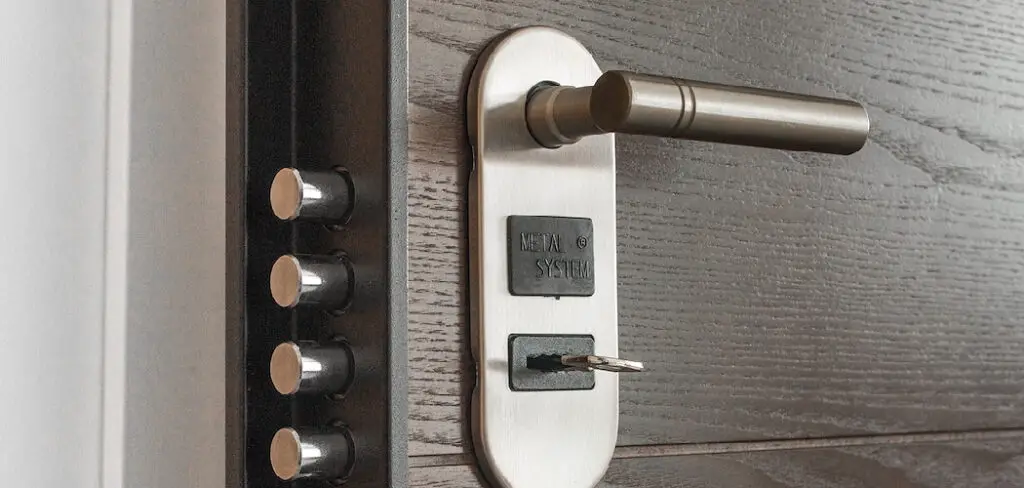
Fortunately, there are other ways to add extra security to your doors without drilling holes. Let’s take a look at some of the best methods for how to put a lock on a door without drilling.
What is a Non-Drilling Door Lock?
A non-drilling door lock, also known as a no-drill door lock or adhesive door lock, is a type of lock that can be installed without the need for any drilling. These locks typically use adhesive strips or pads to attach to the surface of the door and do not require any additional hardware. They are a great alternative to traditional door locks, especially for renters or those who do not want to damage their doors. You can easily remove these locks without leaving any marks or holes behind.
But before you install a non-drilling door lock, it’s important to understand the different types available and how they work.
Can You Put a Lock on A Door without Drilling?
It is indeed possible to place a lock on a door without having to drill it. This can be done using various adhesive products such as sticky mats, glue dots, and adhesives specially designed for the purpose.

An adhesive-backed lock allows users to stick one part of the locking mechanism onto the door while the other part is then slid into position, holding the two securely together.
Not only does this method keep your door secure from unauthorized access, but it also provides privacy since there’s no need to drill or affect the structure of your door in any way whatsoever.
Adhesive locks may not be suitable for outdoor doors since they are much less secure against physical intrusion than conventional locks, but for interior doors and other limited entry points, adhesive locks could be just what you need — a fast and efficient solution that requires relatively little effort and won’t damage your property.
Why Should You Put a Lock on A Door without Drilling?
Nobody wants to deal with the hassle of drilling a door to install a lock, but many people don’t realize there is an easier way to secure your property without breaking out a drill.
With no-drill locks, installation is easy and can be done by one person in a matter of minutes. Utilizing no-drill technology, these locks will hold just as securely as a standard lock and don’t require any damage to your home or business.
A no-drill lock will also save you money in the long run as there are far fewer costs associated with installation, no need for new hardware, or expensive labor costs, leaving only the cost of the lock itself to worry about.
So if you have been putting off securing your property due to the thought of drilling, rest assured that there is a better way and one that won’t break the bank.
Needed Materials:
Adhesive Lock (Can Be Found at Most Hardware or Home Improvement Stores):
This will be the main component of your no-drill lock system, so make sure to choose a sturdy and reliable option. You can find adhesive locks in various shapes and sizes, so be sure to measure your door and choose one that will fit properly.
Alcohol or Cleaning Solution:
Before applying the lock, it’s important to clean the area where you will be placing it. This will ensure a strong bond between the lock and the surface of the door.
Screwdriver:
While no drilling is necessary for this method, you may need a screwdriver to tighten any screws or make minor adjustments to the lock.
Optional: Reinforcement Plate:
If you are looking for extra security, you can also purchase a reinforcement plate to add strength to your lock. This is not always necessary but can be an added precaution for high-security areas.
9 Ways to Follow on How to Put a Lock on A Door without Drilling
1. Sliding Bolt Locks
A sliding bolt lock is an effective way to add security to any door without drilling any holes. These locks come in various sizes and styles, so you can find one that fits the style of your door.
Sliding bolt locks can be installed on either side of the door easily and securely with just a few screws. The main benefit of this type of lock is that it can be removed quickly if needed without leaving any damage behind.
2. Deadbolts
Deadbolts are another great way to add extra security without drilling into your door frame. Deadbolts are available in many different sizes and styles, making them ideal for almost any type of door or window frame.
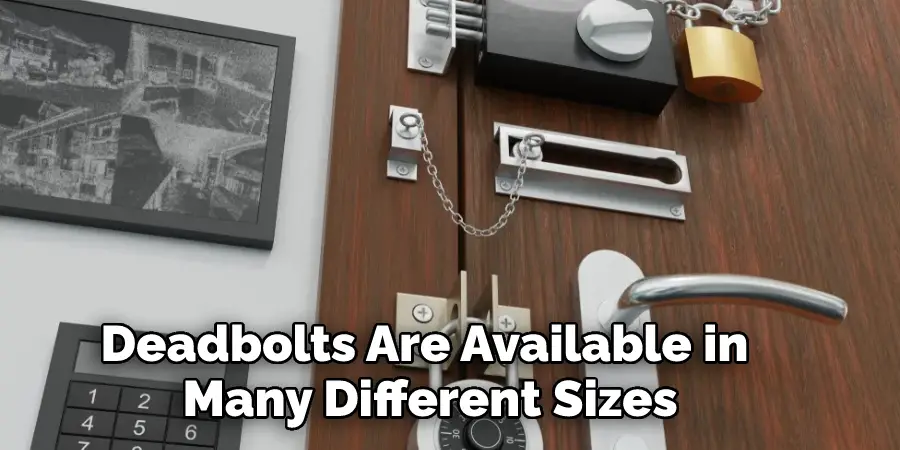
The installation process requires only a few screws and doesn’t require any damage or alteration of the existing structure. Additionally, deadbolts provide an added layer of protection against intruders trying to gain access through the door or window frame.
3. Magnetic Door Locks
Magnetic door locks are becoming increasingly popular as an alternative way to secure doors without having to drill any holes into the frame itself.
These locks use magnets embedded in the frame, which interact with magnets inside the lock itself when it is closed, creating a strong seal that prevents anyone from entering through the doorway unless they have the right combination code or key card.
This type of lock is incredibly secure and easy to install, making it an ideal option for those looking for extra security without drilling any holes into their frames.
4. Chain Locks
Chain locks are a great way to add an extra layer of security without having to drill any holes into the door frame. This type of lock is installed inside the door and consists of a hardened steel chain and a locking mechanism placed over the chain when you close the door. This prevents anyone from opening the door and is easily removable when needed.
5. Door Stops
Door stops are an easy and effective way to add extra security without drilling any holes into your frame. Door stops can be placed along the edges of the door at various points to prevent it from being opened too far.
They can also be used to help reduce noise from slamming doors, making them ideal for homes with pets or children who may not always be careful when closing a door.
6. Strike Plates
Strike plates are another great way to secure a door without drilling holes into the frame. These plates cover the existing hole in the frame, making it much harder for someone to access the door. Also, plates are easy to install and can be removed quickly.
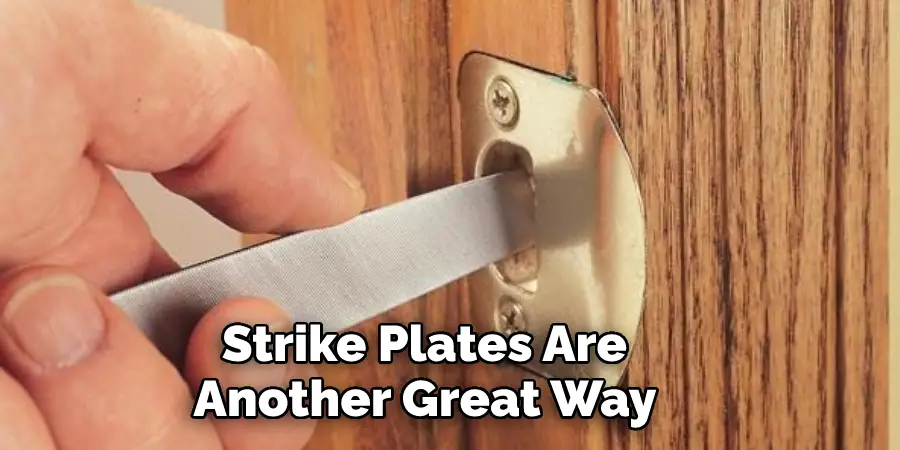
7. Door Reinforcement Kits
Door reinforcement kits effectively add extra security without having to drill any holes into the frame. These kits come with various pieces installed on the door, such as deadbolts, strike plates, and reinforced hinges.
The installation process is straightforward and doesn’t require any tools other than a screwdriver; however, you may need to make some minor adjustments for it to fit properly onto your door frame.
8. Security Bars
Security bars are an excellent way to secure your door without having to drill any holes into the frame. These bars can be installed quickly and easily by simply sliding them against the doorknob and on the bottom of the door.
They provide an extra layer of security, making it much harder for someone to force their way through a closed door. Security bars are also easily removable when needed and leave no damage behind.
9. Adhesive Locks
As mentioned earlier, adhesive locks are an effective way to secure interior doors without drilling holes or causing any damage; they utilize strong adhesive strips to keep them in place. These locks are typically used for cabinets, drawers, or other limited access points within a building.
The installation process only takes a few minutes, and the locks can be easily removed without causing any damage to the surface they were attached to. Adhesive locks are a perfect solution for added security in spaces where drilling isn’t ideal or possible.
That’s it! You’ve now learned how to put a lock on a door without drilling. Whether you choose a sliding bolt lock, deadbolt, magnetic door lock, chain lock, door stop, strike plate, or door reinforcement kit, you can be sure that your home will remain secure and safe!
Things You Need to Know Before Putting a Lock on A Door without Drilling
Before putting a lock on a door without drilling, there are some important things to consider. First, if the door is made of hollow material such as lightweight wood paneling or particle board, it will not be able to hold the weight of the lock.
Therefore, before installing a lock, you need to make sure that your door is made from a strong and heavy material, such as solid-core wood or metal. It’s also important to choose locks that fit properly within the handle opening and are compatible with an existing keyed cylinder or deadbolt lock if already installed.
Furthermore, check with your landlord before editing any aspects of your rented property, such as adding extra locks, as they may have restrictions in place. Ultimately, ensuring your door frame is robust and compatible with the type of lock you want to install should give your door added security.
Benefits of Putting a Lock on A Door without Drilling
Having the security and peace of mind that comes with having a locked door without having to drill through walls is an increasingly popular option for many homeowners.
Installing a door lock without drilling allows for property safeguarding quickly and efficiently without creating any mess or concerns about property damage. An added benefit of not having to do any wall drilling is decreased installation times and cost savings from not requiring professional assistance.
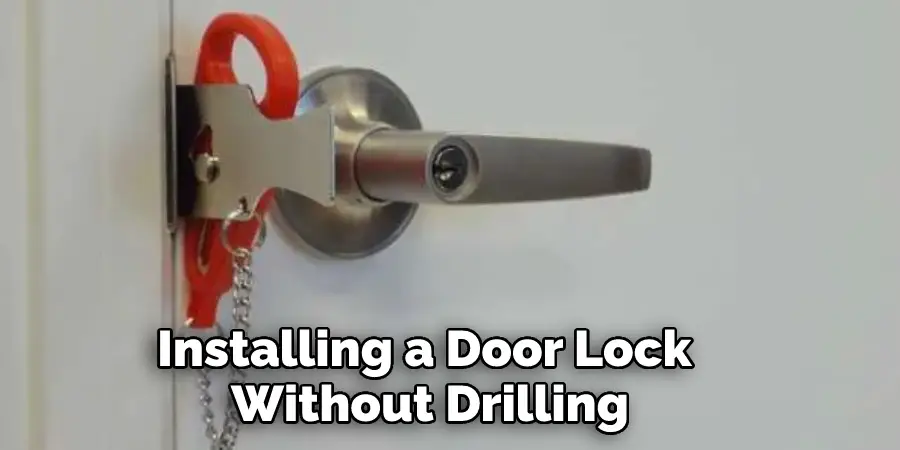
Not having to worry about mixing mud, sanding down surfaces, or potentially damaging preexisting paint jobs also makes this an attractive option. However, homeowners should remember the importance of properly installing the lock they choose to ensure effectiveness.
5 Common Mistakes People Make When Trying to Putting a Lock on A Door without Drilling
1. Not Lining Up the Keyhole With the Deadbolt
One of the most common mistakes people make when trying to put a lock on a door is not lining up the keyhole with the deadbolt. This can be a difficult task, especially if you are not used to doing it. If you are having difficulty, take a look at the instructions that came with your lock or ask someone for help.
2. Not Inserting the Key Far Enough
Another common mistake people make is not inserting the key far enough into the keyhole. This can cause the key to get stuck and make it difficult to turn. If you find that your key is getting stuck, try wiggling it back and forth until it loosens up, and you can insert it further.
3. Turning the Key Too Far
Another mistake people make is turning the key too far when they are trying to put a lock on a door. This can damage the mechanism inside the lock and make it difficult to open. If you find that you have turned the key too far, stop and try again.
4. Not Holding the Knob in Place
When putting a lock on a door, it is important to hold the knob in place with one hand while inserting the key with the other hand. If you do not hold the knob in place, it can be difficult to turn the key and unlock the door.
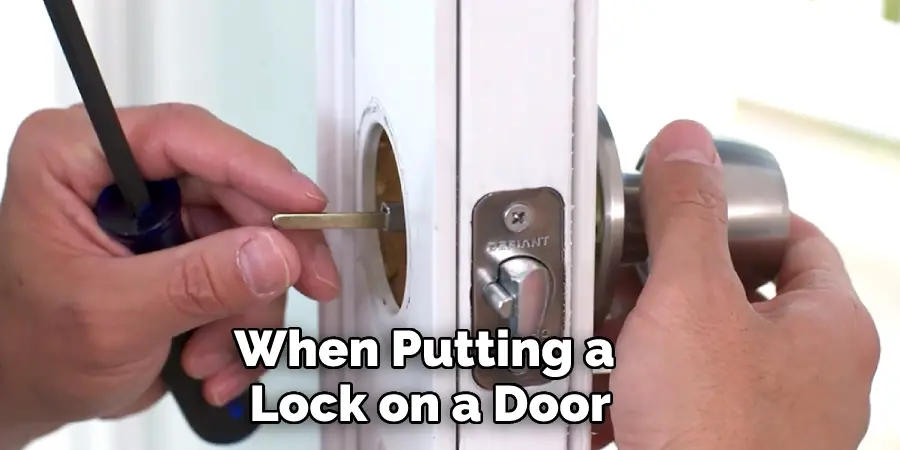
5. Forcing the Lock
One final mistake people make when trying to put a lock on a door is forcing the lock. This can damage the mechanism and make it more difficult to open the door in the future. If you have difficulty inserting the key or turning it, stop and try again.
Frequently Asked Questions:
Q: Can I Put a Lock on a Door Without Drilling?
A: Yes, there are many different types of locks that can be installed without drilling. Some options include adhesive locks, security bars, and door reinforcement kits. You may need to make some minor adjustments for the lock to fit properly onto your door frame.
Q: How Do I Install an Adhesive Lock?
A: To install an adhesive lock, first clean the surface where the lock will be placed. Then, remove the backing from the adhesive strips and firmly press the lock onto the surface. Hold it in place for a few minutes to allow the adhesive to bond properly. You may need to wait up to 24 hours before using the lock to ensure it is securely attached.
Q: Can I Remove an Adhesive Lock Without Damaging My Door?
A: Yes, adhesive locks are designed to be easily removable without causing any damage to the surface they were attached to. To remove the lock, simply use a hairdryer on low heat to warm up the adhesive and gently peel off the lock. Any remaining residue can be removed with rubbing alcohol.
Q: How Do I Know If My Door Is Compatible With an Adhesive Lock?
A: It is important to make sure your door is made of strong and heavy material before installing an adhesive lock. You should also check that the lock fits properly within the handle opening and does not interfere with any existing locks on the door. If in doubt, consult the manufacturer’s instructions or seek professional assistance.
Q: Will Adding Extra Locks Void My Home Insurance?
A: It is important to check with your home insurance provider before adding any extra locks to your property. Some providers may have specific requirements or restrictions in place, and not following them could potentially void your coverage. Make sure to communicate with your insurance company and adhere to their guidelines for added security measures.
Overall, having a locked door is essential for maintaining the safety and security of your home. While traditional drilling and installation methods may be effective, there are alternative options available for those looking to avoid any potential damage or inconvenience.
Conclusion
Securing your home should be a top priority no matter what method you choose – whether it’s drilling into your frames or not! Of course, drilling isn’t always necessary; there are plenty of options out there that won’t cause damage but will still provide you with peace of mind when it comes to keeping your family safe from intruders or unwanted visitors.
From sliding bolt locks and deadbolts all the way up to magnetic locks – make sure you do your research before deciding which one is right for you! With these tips in mind, you’ll be able to find a solution that fits both your needs and budget perfectly! Thanks for reading our post about how to put a lock on a door without drilling.
